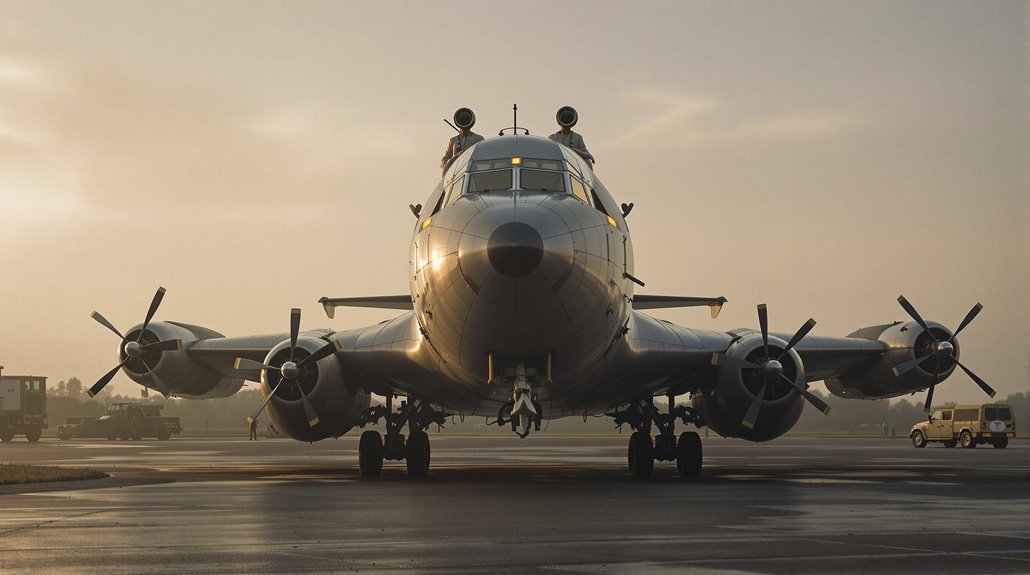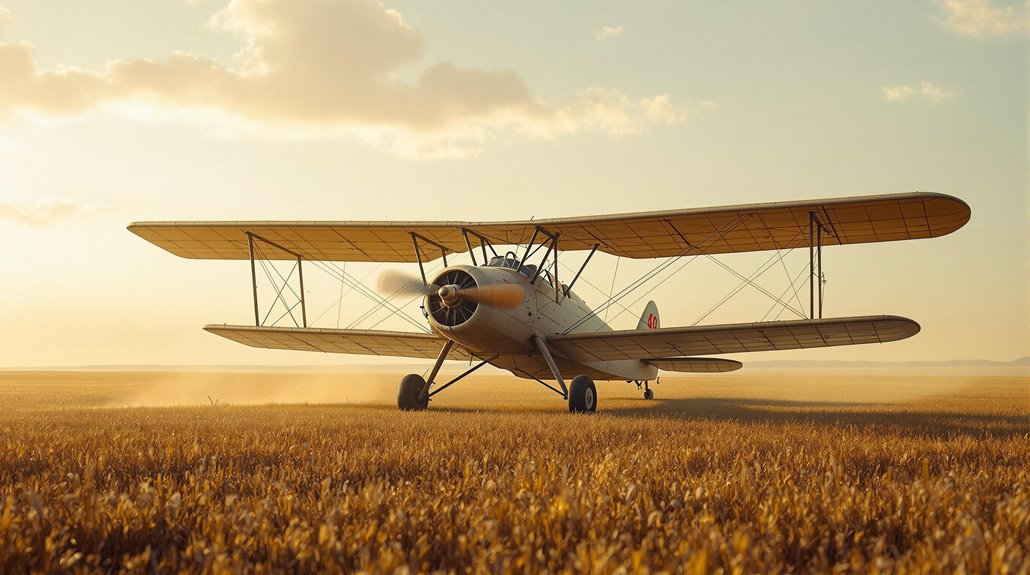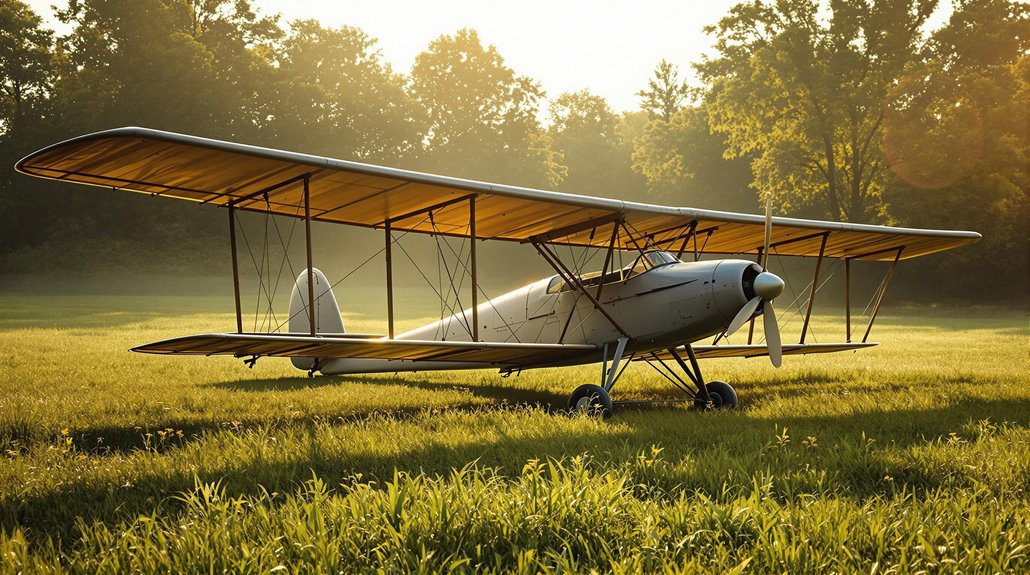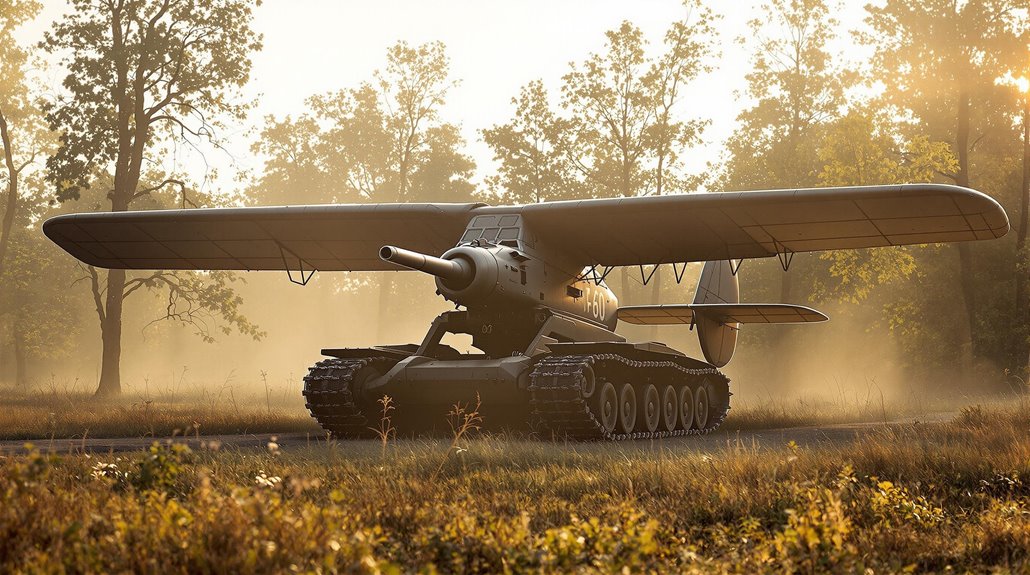They Wanted a Flying Tank—Seriously
Would you believe that military engineers once dreamed of tanks dropping from the sky? You've probably imagined some wild military inventions, but the flying tank concept wasn't just a fantasy—it was a real pursuit that captured imaginations in the 1930s. The Soviet Union, in particular, took this audacious idea seriously enough to build and test the A-40, complete with wings and a glider design. What drove these brilliant minds to attempt such an impossible feat? The answer lies in a fascinating tale of wartime innovation.
The Origins of an Audacious Military Dream

While modern militaries rely on heavy transport aircraft to move tanks, the concept of a self-flying tank emerged in the 1930s as an ambitious solution to battlefield mobility.
You might think it sounds far-fetched, but American engineer J. Walter Christie led this bold military innovation with a design featuring detachable wings and a propeller powered by the tank's own engine.
The idea wasn't just a wild fantasy – it addressed real strategic needs. Military planners wanted to surprise enemy forces and rapidly deploy armored vehicles to distant battlefields. The Soviets made significant progress when they successfully tested modified tankettes suspended under TB-3 bombers.
However, the engineering challenges were formidable. Christie's experimental M1928 high-speed tank demonstrated the potential for enhanced mobility, reaching impressive speeds on the ground, but adding flight capability proved far more complex. Designers had to balance heavy armor with flight capabilities while creating reliable systems for both air and ground operations.
Though Christie built a prototype without wings, the concept remained largely theoretical as nations struggled to overcome these technical hurdles.
Soviet Union's Bold Vision Takes Flight
Despite the engineering challenges that doomed earlier attempts, the Soviet Union launched the most ambitious flying tank program during World War II. Under the guidance of designer Oleg Antonov, Soviet innovation produced the A-40, a modified T-60 light tank fitted with massive biplane wings spanning 60 feet.
The military strategy behind this audacious project was multifaceted: you'd rapidly deploy armor to critical areas, support forces behind enemy lines, and counter German advantages. The Soviets adapted tank controls for flight and designed detachable wings for quick conversion back to ground operations. The design required removing guns and ammunition to reduce weight. The project was developed as a direct response to the German invasion of the Soviet Union.
In September 1942, test pilot Sergei Anokhin successfully glided the 7.8-tonne behemoth, proving the concept viable.
However, the lack of aircraft powerful enough to tow the A-40 ultimately grounded this revolutionary weapon system.
The Remarkable A-40: Engineering Against All Odds
The A-40's engineering specifications reveal the sheer audacity of Soviet military innovation during World War II.
You're looking at a glider design that pushed engineering limits with its massive 18-meter wingspan and ability to carry a 4,418-pound tank. The project faced incredible technical hurdles that showcased remarkable ingenuity. The GAZ-202 engine provided modest propulsion for limited self-powered movement.
- The detachable cradle system allowed quick separation of wings and tail on the battlefield
- Tank crews controlled the aircraft through an innovative system of cables and mirrors
- Wings were nearly twice the size of fighter planes to support the unprecedented weight
Despite the technical achievements in creating this unique aircraft, the A-40 ultimately proved impractical.
The challenges of finding aircraft powerful enough to tow it and ensuring structural integrity during flight led to the project's cancellation after just one prototype was built in 1942.
Testing Day: When Tanks Had Wings
On a fateful September morning in 1942, Soviet test pilot Sergei Anokhin prepared to attempt what many thought impossible – flying a tank through the sky.
The modified T-60 tank, stripped of its turret, ammo, and fuel, now sported wooden wings covered in fabric. A TB-3 bomber would tow this 17,205-pound hybrid creation at 160 km/h.
The test flight didn't go as planned. When the TB-3's engines began overheating, Anokhin had to make an early release.
He managed to glide the tank-aircraft hybrid to a safe landing in a nearby field, only to be detained by bewildered Red Army soldiers who couldn't believe their eyes.
While this singular flight proved tanks could technically fly, the project's impracticality led to its abandonment by February 1943. The concept was originally developed by the Grokhovskiy Special Design Bureau, which had been experimenting with various military air transport vehicles since 1930.
Global Race for Air-Ground Supremacy

Since World War II's experimental flying tanks, modern air-ground supremacy has evolved into a complex technological race.
The aircraft evolution you're witnessing today shows how military innovation has shifted from traditional air superiority to contested airspace scenarios. Network-centric warfare has revolutionized how air forces coordinate and execute missions. Achieving air parity or superiority remains a critical factor in successful military operations. You'll find AI-operated planes and UCAVs leading this transformation, capable of performing maneuvers that human pilots can't match.
Today's air warfare landscape includes:
- Low-cost drones that have democratized air power, allowing smaller actors to compete
- Advanced sensor networks combining satellite constellations with powerful processors
- Multi-effector systems designed to counter various aerial threats simultaneously
You're seeing a fundamental shift where the "window of dominance" concept replaces absolute air superiority.
This new reality demands adaptive strategies and innovative solutions for maintaining battlefield advantage in mutually contested airspaces.










